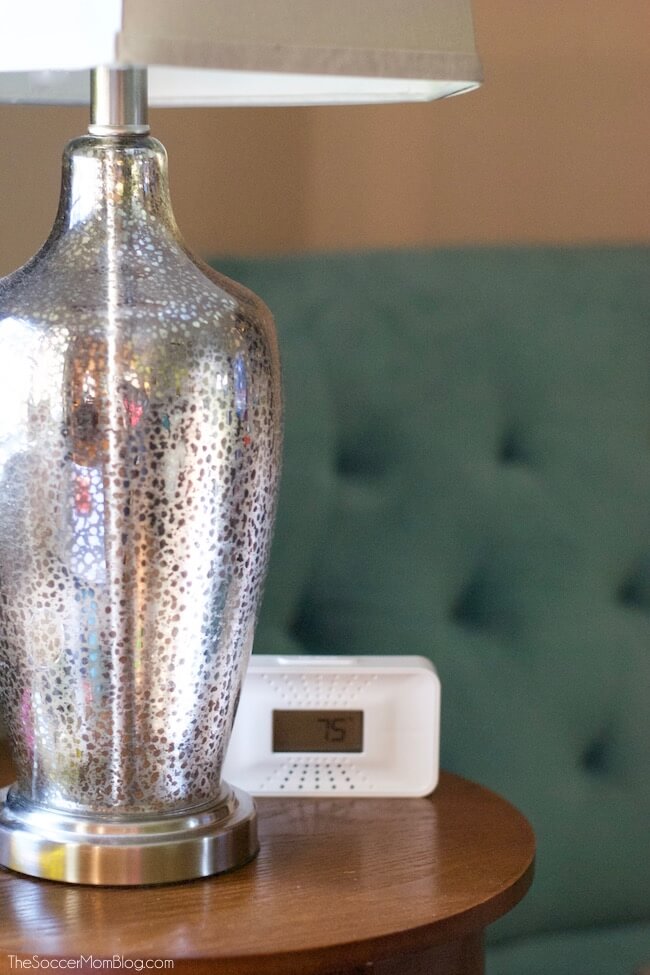Inside: How often to replace smoke detectors in your home, plus the best types of smoke alarms and carbon monoxide detectors to keep your family safe. Sponsored by First Alert.
When was the last time your replaced your smoke alarm (not just the battery, but the entire device)?
What about your carbon monoxide detector?
I’ll be honest — I used to assume that you only needed to replace your smoke alarm if it stopped working. However, waiting for a smoke or carbon monoxide detector to fail puts your family in danger.
October is Fire Prevention Month, so I decided it was a good time to make sure our home is fully protected.
First Alert sent our family a lot of helpful resources, as well as a variety of new smoke alarms and carbon monoxide detectors. I was actually a bit surprised by what I learned, what I thought I knew, and what steps I could take to keep our family safer.
Related: The Home Fire Drill that Could Dave Your Family’s Life
How Often Do You Need to Replace Smoke Detectors?
Home fire injuries and deaths are often preventable — that’s why it’s so incredibly important to equip your home and educate yourself and your family on fire safety.
In fact, according to the National Fire Protection Association, 3 out of every 5 home fire deaths happened in houses with no working smoke alarms.
Even more frightening is the so-called “silent killer,” also known as carbon monoxide. Carbon monoxide is an invisible and odorless gas that is impossible to detect without an alarm and can cause serious long-term health effects and even death.
Smoke alarms and carbon monoxide detectors should be replaced every ten years, even if they still appear to be in good working condition.
What to Look for in a Smoke Detector
- Upgrade to newer devices that contain 10-year sealed batteries. This way you can “set it and forget it,” and not worry about replacing batteries for the life of the alarm. These sealed batteries are also tamper-proof.
- Evaluate your home layout when purchasing, making sure that you choose the right model(s) for your specific needs.
- Check with your local authorities to see if there are any legislative requirements regarding fire protection and/or smoke alarms.
Related: What I Learned Living Through Two Hurricanes & Hurricane Supply Checklist
How to Choose the Right Smoke Alarm and Carbon Monoxide Detector
All smoke alarms and CO detectors are not created equal. I was surprised how many options are out there!
The following are some of my top choices and what we use in our own home:
First Alert PRC710 Combination Smoke and Carbon Monoxide Alarm
PRC710 Features and benefits:
- Provides both smoke/fire and carbon monoxide protection
-
Included sealed 10-year battery requires no battery changes (and no low-battery chirps)
- Slime profile design is half the depth of a standard alarm
- Patented smoke entry system reduces the chance of a false alarm
First Alert CO710 Carbon Monoxide Detector
CO710 features and benefits:
- Portable and easy to add to any room
- Small size is an ideal tabletop addition
- If you plan on moving, you can take it with you
First Alert SA3210 Smoke and Fire Alarm
SA3210 features and benefits:
- Provides overall fire protection because it has both types of smoke sensors recommended by the National Fire Protection Association (NFPA)
- 10 year alarm life with no battery replacement needed
First Alert P1010 Smoke & Fire Alarm
P1010 features & benefits:
- Ideal for the bedroom
- Small, unobtrusive design
- 360° advance smoke entry system
- 10 year alarm life (no need to replace batteries for life of alarm)
CLICK HERE for more information about Fire Safety Month and the smoke alarms and carbon monoxide detectors shown here.
Two important things every family needs for fire safety:
To protect your home and family, make sure that you have both a home safety checklist as well as a fire escape plan. Fire Prevention Month is a good excuse to prepare these items if you haven’t already!
Essentials for a home safety checklist:
- Testing smoke alarm and CO detector functionality
- Noting alarm expiration dates and replacing them if needed
- Installing smoke and carbon monoxide alarms on every level of the home
- Scheduling a service appointment for your furnace
- Cleaning dryer vents
- Practicing your family’s fire escape plan (see below)
How to create a fire escape plan:
- Draw a map of your home to the best of your ability, including all windows and doors.
- Identify two ways out of each room (doors and windows could both work).
- Designate a meeting place outside the home where you’ll go after you escape.
- Assign an escape buddy to young children or family members who will need help during a fire emergency.
- Go over the plan as a family to ensure that everyone understands.
- Practice!
TIP: Be sure to involve the kids in fire safety planning and preparations! They’ll have fun, may contribute new ideas, and be more likely to remember if they’re a part of the process.
Watch this video with your kids to get the fire safety conversation started:
Visit FirstAlert.com for more fire safety tips and resources for Fire Prevention Month.
- Marshmallow Playdough - April 18, 2024
- Homemade Fruit Leather Recipe - April 17, 2024
- 7-Layer Dip Cups - April 16, 2024







Tyler Johnson says
That’s good to know that you should replace your fire alarms every 10 years. I wouldn’t want to have a fire or carbon monoxide without being able to know. I’ll have to see if mine needs to be replaced since I don’t know the last time they were looked at.